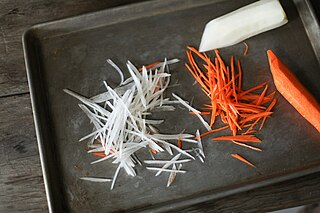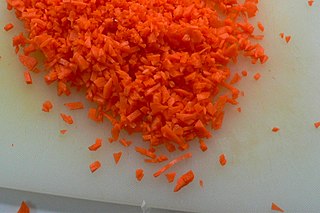 W
WCandy making or candymaking is the preparation and cookery of candies and sugar confections. Candy making includes the preparation of many various candies, such as hard candies, jelly beans, gumdrops, taffy, liquorice, cotton candy, chocolates and chocolate truffles, dragées, fudge, caramel candy, and toffee.
 W
WDeep frying is a cooking method in which food is submerged in hot fat, most commonly oil, as opposed to the shallow oil used in conventional frying done in a frying pan. Normally, a deep fryer or chip pan is used for this; industrially, a pressure fryer or vacuum fryer may be used. Deep frying may also be performed using oil that is heated in a pot. Deep frying is classified as hot-fat cooking method. Typically, deep frying foods cook quickly: all sides of a food are cooked simultaneously as oil has a high rate of heat conduction.
 W
WDicing is a culinary knife cut in which the food item is cut into small blocks or dice. This may be done for aesthetic reasons or to create uniformly sized pieces to ensure even cooking. Dicing allows for distribution of flavour and texture throughout the dish, as well as a somewhat quicker cooking time. Dicing usually applies to vegetables prepared in this way but it can also apply to the preparation of meat or fish and fruit. Brunoise is an especially small size, produced from further cutting of julienne-style food.
 W
WFrying is the cooking of food in oil or another fat. Similar to sautéing, pan-fried foods are generally turned over once or twice during cooking, using tongs or a spatula, while sautéed foods are cooked by "tossing in the pan". A large variety of foods may be fried.
 W
WGimjang (김장), also spelled kimjang, is the traditional process of preparation and preservation of kimchi, the spicy Korean fermented vegetable dish, in the wintertime. During the summer months, Kimchi is made fresh, from seasonal vegetables. For one month, starting from the tenth moon of the year, people prepare large quantities of kimchi, to provide nutrition throughout winter.
 W
WJulienne, allumette, or french cut, is a culinary knife cut in which the food item is cut into long thin strips, similar to matchsticks. Common items to be julienned are carrots for carrots julienne, celery for céléris remoulade, or potatoes for Julienne Fries.
 W
WIn cooking, kneading is a process in the making of bread or dough, used to mix the ingredients and add strength to the final product. Its importance lies in the mixing of flour with water; when these two ingredients are combined and kneaded, the gliadin and glutenin proteins in the flour expand and form strands of gluten, which gives bread its texture. The kneading process warms and stretches these gluten strands, eventually creating a springy and elastic dough. If bread dough is not kneaded enough, it will not be able to hold the tiny pockets of gas created by the leavening agent, and will collapse, leaving a heavy and dense loaf.
 W
WLaminated dough is a culinary preparation consisting of many thin layers of dough separated by butter, produced by repeated folding and rolling. Such doughs may contain over eighty layers. During baking, water in the butter vaporizes and expands, causing the dough to puff up and separate, while the lipids in the butter essentially fry the dough, resulting in a light, flaky product. Examples of laminated doughs include:Croissant pastry Danish pastry Flaky pastry Jachnun Kubaneh Paratha Puff pastry
 W
WThere are a number of regular knife cuts that are used in many recipes. Each produces a standardized cut piece of food. The two basic shapes for these cuts are the strip and the cube. Strips are generally cut to 2 1⁄2–3 inches (6–8 cm), and are defined by width, from thickest to thinnest as "pont-neuf", "batonnet", "allumette", "julienne", and "fine julienne". The cube shapes, in order from largest to smallest, are the large, medium, and small dice, the brunoise, and the fine brunoise.
 W
WMincing is a food preparation technique in which food ingredients are finely divided into uniform pieces. Minced food is in smaller pieces than diced or chopped foods, and is often prepared with a chef's knife or food processor, or in the case of meat by a specialised meat grinder.